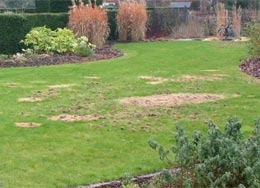Pak Choi is grown for its tasty leaves which are superb when added to stir fries and salads.
The taste is similar to that of mild cabbage and spinach and is a popular addition to many oriental dishes.
 Leatherjackets are the larvae of the Crane Fly, better known as the Daddy Longlegs.
Leatherjackets are the larvae of the Crane Fly, better known as the Daddy Longlegs.
When you start to see the adult daddy-long-legs in your garden (towards the end of August) you will know that in a few days they will be laying eggs. These will hatch quickly, within two weeks. The young start to feed, continuing throughout winter, ready to gorge on grass roots in spring.
During the mild months of late autumn and early spring the larvae will feed voraciously on grass roots, and a sure sign of lawn damage by these pests are dry, yellow patches, which will become ore evident in the spring and early summer.Left untreated these patches will eventually become brown as the grass plants die altogether. Certain birds, especially of the crow family and in particular the magpie, can cause further damage as they tear up the lawn looking to feast on the leatherjackets.
Leatherjackets can also sometimes attack plants in the vegetable plot, eating roots and causing the plants to turn yellow or die completely. Simply digging around the affected plants or lifting an area of dying grass should confirm the presence of leatherjackets. They grow to around 1-2cm in size and are generally dark brown in colour and you can expect to find several within a small area.
| Another common garden pest, which can cause similar damage to lawns and other plants is the Chafer grub. This is the larvae of the Chafer beetle, which lives as an adult beetle for around 2-3 weeks during May and June, then laying eggs in the soil or lawn. The larvae will then spend most of its life in the soil feeding extensively on plant roots. Major infestations can be devastating for lawns and other plants with symptoms becoming evident when the damage has already been done. The grubs can grow to around 2cm in length and are easily identified by their greyish white colour and their curled appearance. |
Chafer Grub |
Leatherjacket Grub |
Unlike the leatherjacket, chafer grubs display typically 3 pairs of legs situated to the front of the body, making them instantly recognisable. It’s usually a plump grub with a light brown head and is a favourite food source of the crow family including starlings, jackdaws, jays and magpies. However, they can also be a tasty meal for foxes and badgers, who will rip up the lawn as they search for them.
Nematodes are a very effective control method because once the host grub has died the nematodes will quickly reproduce, creating a new generation of hungry parasites, which will go in search of new prey. The nematodes are best applied to warm soil in September and before the autumn frosts.
AVAILABLE TO PURCHASE AUGUST - BEGINNING OF OCTOBER
Did you find this post Useful? So will others, please like it on Facebook, or share on Twitter.
Have you any other top tips you think are worth a mention? Please leave a comment below and let us know....
All blog content on this page is copyright of SimplySeed and is not to be reproduced without prior written permission. ©